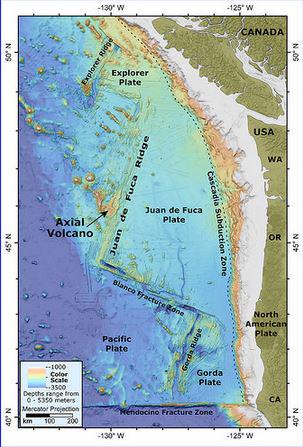PORTLAND, Ore. (KOIN) — A volcano is erupting off of the Oregon coast, scientists at Oregon State University reported.
The underwater volcano, named Axial Seamount, poses no threat to coastal residents, but is causing small earthquakes. It is located 300 miles off of the coast.
“Since last Friday, the region has experienced thousands of tiny earthquakes – a sign that magma is moving toward the surface – and the seafloor dropped by 2.4 meters, or nearly eight feet, also a sign of magma being withdrawn from a reservoir beneath the summit,” scientists wrote on the OSU website.
Researchers had previously predicted that 2015 would be a big year for the underwater volcano. The last time it erupted was 2011.
This discovery could be a big deal for a lot of other reasons.

“It’s a tremendous research opportunity for us,” said Bill Chadwick an Oregon State University research professor at NOAA Pacific Marine Environmental Laboratory.
“I live here in Newport so I’m on the front lines, too,” he said. “It’s really gratifying and exciting.”
For five months, hundreds of small earthquakes were recorded every day. On April 24, there were 8000 earthquakes at Axial Seamount, the spot where scientists believe the volcano is erupting.
Chadwick said most of the earthquakes “were tiny, magnitude 1 or 2. So, even if you’re standing on top of it you probably wouldn’t feel it, or barely.”
Because the quakes were so small, the sea floor movement is minimal and there is no tsunami risk.
And because it’s not in the Cascade Subduction Zone, it does not mean the big catastrophic quake so many fear is near.
“We’re not more likely to have a big earthquake than we were two weeks ago,” Chadwick said.
He and his partner, Scott Nooner of the University of North Carolina Wilmington, were able to forecast or predict this eruption. They hope it helps them to better predict eruptions on land where more people are affected.
What they’re learning here, he said, could help with things like replicating DNA in a lab, finding new antibiotics or cancer-curing drugs.
There may also be big clues here that help in the quest to find life on other planets, he said.
“Everything we know about exploring for life in the universe is kind of based on what we know about hydrothermal vents here on earth,” Chadwick said.